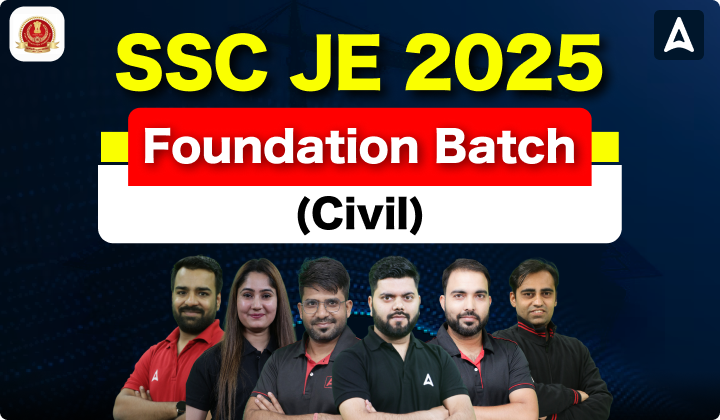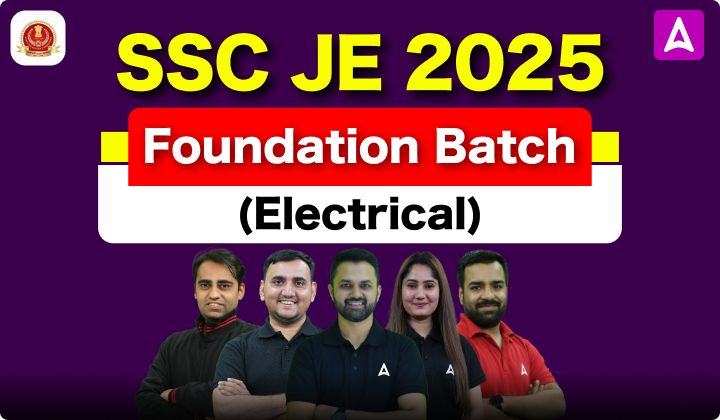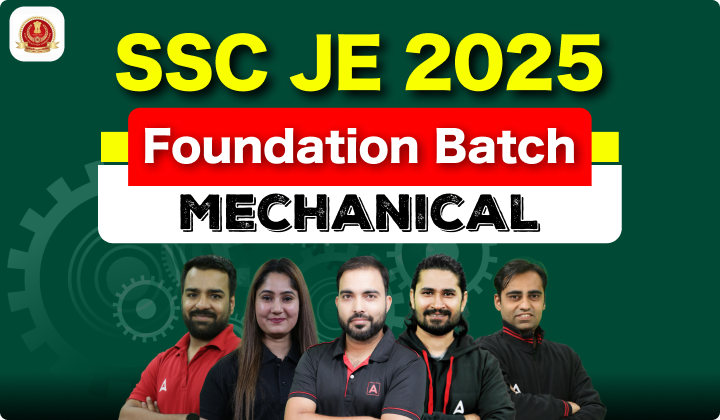If you’re an engineering graduate aiming for a government job, the SSC JE Exam 2025 is a great opportunity. The exam will be held from 27th to 31st October 2025. This article provides essential information about the SSC JE Syllabus 2025 and the updated exam pattern. Familiarizing yourself with the syllabus, exam pattern, and key dates will help improve your preparation and increase your chances of success. Candidates can download detailed SSC JE Syllabus information for each engineering stream – Civil, Electrical, and Mechanical – to focus their preparation effectively.
SSC JE Syllabus and Exam Pattern 2025
The SSC JE Syllabus 2025 is divided into two papers: Paper 1 (Objective) and Paper 2 (Descriptive), designed to assess both general aptitude and core technical knowledge. Paper 1 includes three sections, General Intelligence & Reasoning, General Awareness, and General Engineering (Civil, Electrical, or Mechanical, as per the candidate’s discipline). A clear grasp of the syllabus helps candidates plan their preparation effectively and improves their chances of success in the exam. The SSC JE Notification 2025 has been out candidates who are going to apply can check the syllabus and exam pattern overview from the table below.
| SSC JE Syllabus and Exam Pattern 2025 – Highlights |
| Organization |
Staff Selection Commission |
| Exam Name |
SSC Junior Engineer (SSC JE) Exam 2025 |
| Application Starts |
30th June to 21st July 2025 |
| Name of Post |
Junior Engineer |
| SSC JE Syllabus & SSC JE Exam Pattern |
Available Here |
| Selection Process |
Paper 1 & Paper 2 |
| Official Website |
www.ssc.gov.in |
SSC JE Exam Pattern 2025
The SSC JE Syllabus 2025 has two main stages: Paper I and Paper II.
- Paper I checks your skills in General Intelligence & Reasoning, General Awareness, and basic Engineering related to your chosen field—Civil, Electrical, or Mechanical.
- Paper II is focused only on your specific engineering branch. It covers the core technical subjects of that stream in detail.
To prepare well for this exam, you need to clearly understand the exam pattern and what topics are included in both papers. Here’s an easy-to-understand summary of the SSC JE 2025 exam structure and subject distribution.
| Papers |
Type of Examination |
Subjects |
Mode of examination |
| Paper 1 |
Objective Multiple Choice |
(i) General Intelligence and Reasoning
(ii) General Awareness
(iii) Part-A General Engineering (Civil & Structural) or
Part B General Engineering (Electrical) or
Part-C General Engineering (Mechanical) |
CBT (Online) |
| Paper 2 |
Objective Multiple Choice |
Part-A General Engineering (Civil & Structural)
Part B: General Engineering (Electrical)
Part-C General Engineering (Mechanical) |
CBT (Online) |
SSC JE Paper 1 Exam Pattern 2025
The SSC JE 2025 Paper 1 is the first stage of the selection process for the SSC Junior Engineer exam. This paper is very important for candidates who want to move forward in the recruitment process.
- It includes three sections: General Knowledge, General Awareness, and General Engineering (based on Civil, Electrical, or Mechanical branch). All the questions in this paper are multiple-choice (objective type).
- The total time given to complete the exam is 2 hours. To qualify for the next stage, candidates must pass Paper 1 by scoring the required marks.
- There is also negative marking; 0.25 marks will be deducted for every wrong answer.
| SSC JE 2025 Paper 1 Exam Pattern |
| Papers |
No. Of Questions |
Maximum Marks |
Duration |
| General Intelligence & Reasoning |
50 |
50 |
2 Hrs. |
| General Awareness |
50 |
50 |
| Part –A General Engineering (Civil & Structural) OR |
100 |
100 |
| Part B: General Engineering (Electrical) OR |
| Part-C General Engineering (Mechanical) |
| Total |
200 |
200 |
SSC JE Paper 2 Exam Pattern 2025
Candidates who pass the SSC JE 2025 Paper 1 cut-off will move on to take SSC JE Paper 2:
- The SSC JE Paper 2 is a computer-based test.
- Paper 2 will have questions only from the technical subject related to the candidate’s chosen educational qualification.
- SSC JE 2025 Paper 2 is worth a total of 300 marks.
- There is a negative marking of 1 mark for each incorrect answer in Paper 2 of the SSC JE 2025 exam.
| SSC JE 2025 Paper 2 Exam Pattern |
| Paper 2 |
Questions |
Marks |
Time |
| Part-A General Engineering (Civil & Structural) |
100 |
300 |
2 Hrs. |
| OR |
| Part B: General Engineering (Electrical) |
100 |
300 |
2 Hrs. |
| OR |
| Part-C General Engineering (Mechanical) |
100 |
300 |
2 Hrs. |
SSC JE Paper 1 Syllabus 2025
The SSC JE Paper 1 Syllabus includes three main sections: General Intelligence & Reasoning, General Awareness, and General Engineering (Civil & Structural, Electrical, and Mechanical). The syllabus is divided into two components: General Intelligence & Reasoning, General Awareness, and General Engineering (Civil and Structural, Electrical & Mechanical). In the General Intelligence & Reasoning section, candidates can expect topics such as classification, analogy, coding-decoding, and more. The details of the SSC JE syllabus are given below:
| Section |
Topics |
| General Intelligence & Reasoning |
- Analogies
- Similarities and Differences
- Space Visualization
- Problem Solving
- Analysis
- Judgment
- Decision Making
- Visual Memory
- Discrimination
- Observation
- Relationship Concepts
- Arithmetical Reasoning
- Verbal and Figure Classification
- Arithmetical Number Series
- Dealing with Abstract Ideas and Symbols
- Arithmetical Computations
- Analytical Functions
|
| General Awareness |
- Current Affairs (National & International)
- India and its Neighbouring Countries
- History of India
- Indian Culture
- Geography (Physical, Social & Economic aspects)
- Indian Polity and Constitution
- Economic Scene
- Scientific Research and Discoveries
- General Science
- Environmental Issues
- Important Government Schemes and Policies
- Awards and Honours
- Books and Authors
- Sports
- Static GK (e.g., national symbols, important days, etc.)
|
| Mechanical Engineering |
- Theory of Machines and Machine Design
- Engineering Mechanics & Strength of Materials
- Thermodynamics (1st & 2nd Laws)
- IC Engines (Performance, Combustion, Cooling & Lubrication)
- Air Standard Cycles (Otto, Diesel)
- Rankine Cycle & Boilers
- Air Compressors & Refrigeration Cycles
- Steam Nozzles & Turbines
- Fluid Mechanics & Machinery
- Measurement of Flow & Pressure
- Hydraulic Turbines & Centrifugal Pumps
- Classification of Steel & Basic Production Engineering
|
| Electrical Engineering |
- Basic Electrical Concepts
- Circuit Laws (Ohm’s Law, Kirchhoff’s Laws)
- Magnetic Circuits
- AC Fundamentals
- Measurement & Measuring Instruments
- Electrical Machines (DC & AC)
- Fractional Kilowatt Motors & Single-Phase Induction Motors
- Synchronous Machines
- Generation, Transmission & Distribution of Electrical Power
- Estimation and Costing
- Utilization of Electrical Energy (Heating, Welding, Lighting, etc.)
- Basic Electronics (Diodes, Transistors, BJTs, JFETs)
|
| Civil Engineering |
- Building Materials
- Estimating, Costing, and Valuation
- Surveying
- Soil Mechanics
- Hydraulics
- Irrigation Engineering
- Transportation Engineering
- Environmental Engineering
- Structural Engineering: Theory of Structures, Concrete Technology, RCC Design, Steel Design
|
SSC JE Paper 2 Syllabus for Civil Engineering
In this section, we have covered the detailed SSC JE Paper 2, which will follow an objective format. Check out the SSC JE 2025 Syllabus for Civil Engineering below:
| SSC JE Civil Engineering Syllabus |
| Subjects |
Topics |
| Building Materials |
- Physical and chemical properties
- Classification- Standard tests
- Use and manufacture/quarrying
- Materials: Building stones, silicate-based materials, Portland cement, asbestos products, timber, wood-based products, laminates, bituminous materials, paints, varnishes
|
| Estimating, Costing, and Valuation |
- Estimate, glossary of technical terms
- Analysis of rates, methods, units of measurement
- Items of work: Earthwork, brickwork, RCC, shuttering, timber work, painting, flooring, plastering, boundary wall, water tank, septic tank
- Methods: Bar bending schedule, centre line method, mid-section formula, trapezoidal formula, Simpson’s rule
- Cost estimates: Septic tank, pavements, tube wells, footings, steel truss, piles, pile caps
- Valuation: Value and cost, scrap value, salvage value, assessed value, sinking fund, depreciation, obsolescence, valuation methods
|
| Surveying |
- Principles, distance measurement
- Chain surveying, compass, plane table
- Bearings, local attraction
- Theodolite traversing and adjustments
- Levelling, contouring, corrections
- Dumpy level adjustments
- Contour mapping and uses
- Tachymetry, curve setting, earthwork calculation
- Advanced surveying equipment
|
| Soil Mechanics |
- Origin, phase diagram
- Definitions: Void ratio, porosity, water content, etc.
- Grain size curves, Atterberg’s limits, ISI classification
- Plasticity chart- Permeability, aquifers, effective stress
- Quicksand, consolidation, pre-consolidation
- Shear strength, compaction
- Earth pressure theories, bearing capacity
|
| Hydraulics |
- Fluid properties and hydrostatics
- Flow measurement- Bernoulli’s theorem and applications
- Flow through pipes and open channels
- Weirs, flumes, spillways- Pumps and turbines
|
| Irrigation Engineering |
- – Definition, need, benefits- Irrigation types and methods- Hydrology: Rainfall, runoff, rain gauge-
- Crop water needs: Duty, delta, base period
- – Crops: Kharif & Rabi- Canal systems and lining- Wells, weirs, flood control-
- Water logging, land reclamation
- – Major Indian irrigation projects
|
| Transportation Engineering |
- Highway engineering: Cross-sectional elements, Geometric design, Pavement types & materials, Flexible and rigid pavement design
- Maintenance and drainage
- Railway engineering:
- Permanent way components
- Track geometry
- Points and crossings
- Traffic engineering:
- Surveys
- Intersections and interchanges
- Traffic signals
- Road safety
|
| Environmental Engineering |
- Water quality and sources
- Water purification and distribution
- Sanitation and sewerage systems
- Sewage treatment
- Solid waste management
- Air pollution: causes, effects, control
- Noise pollution: causes, effects, control
|
| Theory of Structures |
- Elasticity constants
- Beam types: determinate and indeterminate
- Bending moment and shear force diagrams
- Moment of inertia
- Shear stress: tee, channel, compound sections
- Eccentric loads
- Slope deflection method
- Columns and critical load
- Torsion of circular sections
|
| Concrete Technology |
- Properties and uses of concrete
- Cement, aggregates, water-cement ratio
- Workability and mix design
- Storage, batching, mixing
- Placement, compaction, finishing, curing
- Quality control measures
- Hot and cold weather concreting
- Concrete repair and maintenance
|
| RCC Design |
- RCC beams:
- Flexural, shear, and bond strength
- Singly and doubly reinforced
- Cantilevers, T-beams, lintels
- Slabs: one-way and two-way
- Footings: isolated types
- Columns, staircases
- Retaining walls, water tanks
- Design approaches:
- Limit state method
- Working stress method
|
| Steel Design |
- Steel column and beam design
- Roof trusses
- Plate girders
|
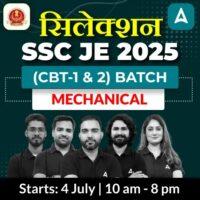
SSC JE Paper 2 Syllabus for Electrical Engineering
The SSC Junior Engineer Syllabus 2025 for Electrical Engineering is given below:
| SSC JE Electrical Engineering Syllabus |
| Subjects |
Topics |
| Basic Concepts |
- Resistance, inductance, capacitance
- Factors affecting R, L, and C
- Current, voltage, power, energy
- Units of electrical quantities
|
| Circuit Law |
- Kirchhoff’s Current and Voltage Laws
- Simple circuit solutions using:
- Network theorems
|
| Magnetic Circuit |
- Flux, MMF (Magneto-Motive Force), and reluctance
- Types of magnetic materials
- Magnetic field calculations for:
- Straight conductors
- Circular loops
- Solenoids
- Electromagnetic induction
- Self and mutual induction
|
| AC Fundamentals |
- Instantaneous, peak, RMS, and average values
- Sinusoidal waveform representation
- Simple series and parallel AC circuits (R, L, C)
- Resonance, tank circuit
- Polyphase systems:
- Star and delta connection
- 3-phase power concepts
- DC and sinusoidal response of R-L and R-C circuits
|
| Measurement and Measuring Instruments |
- Power and energy measurement:
- Single-phase and three-phase (active/reactive)
- 2-wattmeter method for 3-phase power
- Measurement of frequency and phase angle
- Instruments:
- Ammeter and voltmeter (moving coil and moving iron)
- Wattmeter (range extension)
- Multimeter, megger, energy meter
- AC bridges
- CRO and signal generator
- CT (Current Transformer) and PT (Potential Transformer)
- Earth fault detection methods
|
| Electrical Machines |
- DC Machines
Construction and working principles
- Characteristics of DC motors and generators
- Speed control methods
- Starting and braking of DC motors
- Losses and efficiency analysis
- (b) Transformers
Single-phase and three-phase transformers
- Construction and working principle
- Equivalent circuit, voltage regulation
- OC (Open Circuit) and SC (Short Circuit) tests
- Losses and efficiency
- Effect of voltage, frequency, and waveform
- Parallel operation of transformers
- Auto-transformers
- (c) Induction Motors
3-phase induction motor construction and working
- Rotating magnetic field
- Torque-speed characteristics
- Starting and speed control methods
- Braking techniques
- Impact of voltage and frequency on performance
|
| Generation, Transmission & Distribution |
- Power station types
- Load factor, diversity factor, demand factor
- Cost of generation and station interconnection
- Power factor improvement
- Tariff types
- Faults and symmetrical short circuit current
- Switchgear basics:
- Circuit breaker ratings
- Arc extinction (oil, air)
- HRC fuses
- Protection systems:
- Earth leakage, overcurrent
- Buchholtz relay
- Merz-Price protection (generators & transformers)
- Feeder and busbar protection
- Lightning arresters
- Transmission & distribution systems
- Cable types, ratings, derating factors
- Comparison of conductor materials and system efficiency
|
| Utilization of Electrical Energy |
- Illumination systems
- Electric heating and welding
- Electroplating
- Electric drives and industrial motors
|
Life of a Junior Engineer After Clearing SSC JE
SSC JE Paper 2 Syllabus for Mechanical Engineering
The SSC JE Syllabus 2025 for Mechanical Engineering is given below:
| SSC JE Syllabus Mechanical Engineering 2025 |
| Subjects |
Topics |
| Theory of Machines and Machine Design |
- Simple machine concept
- Four-bar linkage, link motion
- Flywheels and energy fluctuation
- Power transmission (V-belts & Flat belts)
- Clutches: Plate and Conical
- Gears: Types, profiles, gear ratio calculation
- Governors: Principles and classification- Riveted joints- Cams and bearings- Friction in collars and pivots
|
| Engineering Mechanics and Strength of Materials |
- Equilibrium of forces
- – Laws of motion
- – Friction concepts
- – Stress and strain, elastic limit, elastic constants
- – Bending moment and shear force diagrams
- – Stress in composite bars
- – Torsion in circular shafts
- – Buckling of columns: Euler’s and Rankine’s theories
- – Thin-walled pressure vessels
|
| Properties of Pure Substances |
- – p-v and P-T diagrams (e.g., H₂O)
- – Steam tables and steam generation
- – Saturated, wet, and superheated steam
- – Dryness fraction and degree of superheat
- – Mollier’s (h-s) chart
|
| 1st Law of Thermodynamics |
- – Stored/internal energy definition
- – 1st Law for cyclic process
- – Non-flow and flow energy equations
- – Enthalpy definition
- – Steady State Steady Flow (SSSF) conditions
- – SSSF Energy Equation
|
| 2nd Law of Thermodynamics |
- Heat reservoir, sink, source
- – Heat engine, heat pump, refrigerator
- – Thermal efficiency & Coefficient of Performance (COP)
- – Kelvin-Planck & Clausius statements
- – Thermodynamic temperature scale
- – Entropy, Clausius integral
- – Entropy changes in ideal gases
- – Carnot cycle & efficiency
- – PMM-2 (definition & impossibility)
|
| Air Standard Cycles for IC Engines |
- – Otto cycle: P-V, T-S diagrams, thermal efficiency
- – Diesel cycle: P-V, T-S diagrams, thermal efficiency
- – IC engine performance, combustion, cooling & lubrication
|
| Rankine Cycle of Steam |
- – Simple Rankine cycle on P-V, T-S, h-s diagrams
- – Efficiency with and without pump work
|
| Boilers |
- – Classification and specifications
- – Boiler fittings and accessories
- – Fire-tube and water-tube boilers
|
| Air Compressors & Refrigeration |
- – Air compressor cycles
- – Refrigeration cycle principles
- – Working of refrigeration plant
|
| Nozzles & Steam Turbines |
– Functioning principles and classifications |
| Properties & Classification of Fluids |
– Ideal vs real fluids- Newton’s law of viscosity- Newtonian & Non-Newtonian fluids- Compressible & incompressible fluids |
| Fluid Statics |
– Pressure at a point |
| Measurement of Fluid Pressure |
– Manometers: U-tube and inclined tube |
| Fluid Kinematics |
– Streamline, laminar & turbulent flow- Internal & external flows- Continuity equation |
| Dynamics of Ideal Fluids |
– Bernoulli’s equation- Total, pressure, and velocity head- Applications of Bernoulli’s principle |
| Measurement of Flow Rate |
– Venturimeter- Pitot tube- Orifice meter |
| Hydraulic Turbines |
– Classifications and working principles |
| Centrifugal Pumps |
– Classifications, working principles, and performance |
| Production Engineering |
- – Steel classification: Mild & alloy steel
- – Heat treatment of steel
- – Welding: Arc, Gas, Resistance, TIG, MIG
- – Brazing, soldering
- – Welding defects and testing (including NDT)
- – Foundry & casting: methods, defects, processes
- – Forging and extrusion
- – Metal cutting principles
- – Cutting tools and machining basics: Lathe, Milling, Drilling, Shaping, Grinding
- – Machines, tools, and manufacturing processes
|
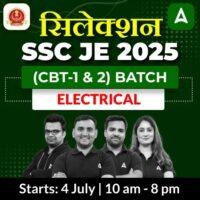
SSC JE Syllabus 2025 PDF
Aspiring candidates should align their study strategies with the official SSC JE Syllabus PDF, available on the SSC website. To improve preparation, candidates are advised to use resources like previous years’ question papers and mock tests to familiarize themselves with the exam format and identify strengths and weaknesses.
SSC JE Syllabus 2025- Click Here to Download PDF
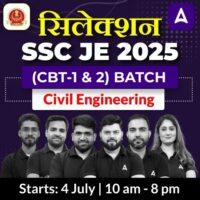
Sharing is caring!

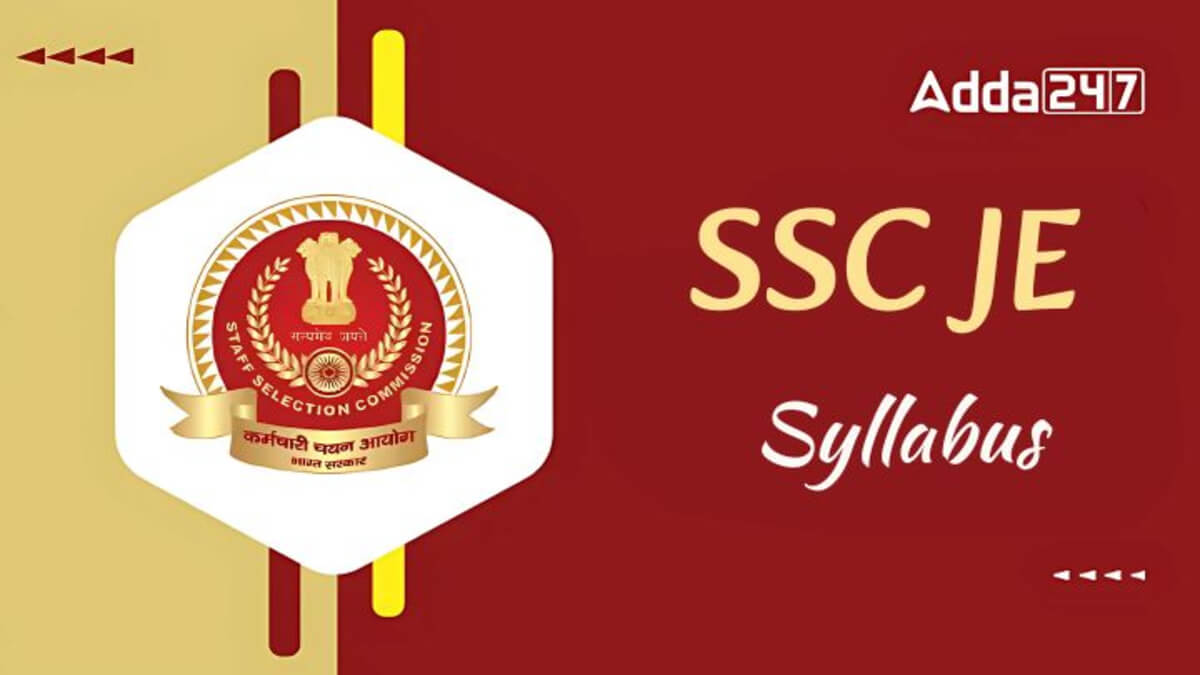




 DFCCIL Syllabus 2025 With New Exam Patte...
DFCCIL Syllabus 2025 With New Exam Patte...
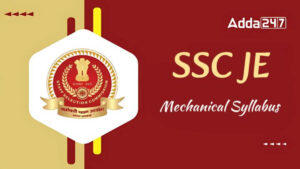 SSC JE Mechanical Syllabus 2025, Subject...
SSC JE Mechanical Syllabus 2025, Subject...
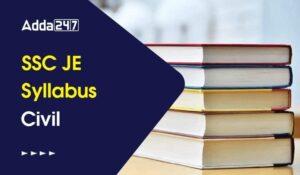 SSC JE Civil Syllabus 2025, Check Comple...
SSC JE Civil Syllabus 2025, Check Comple...
